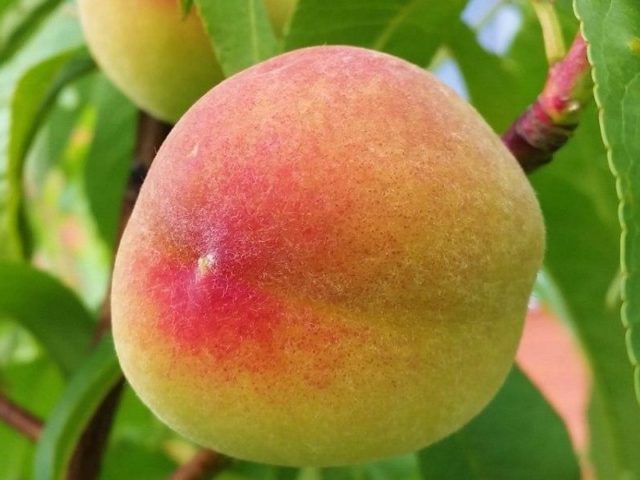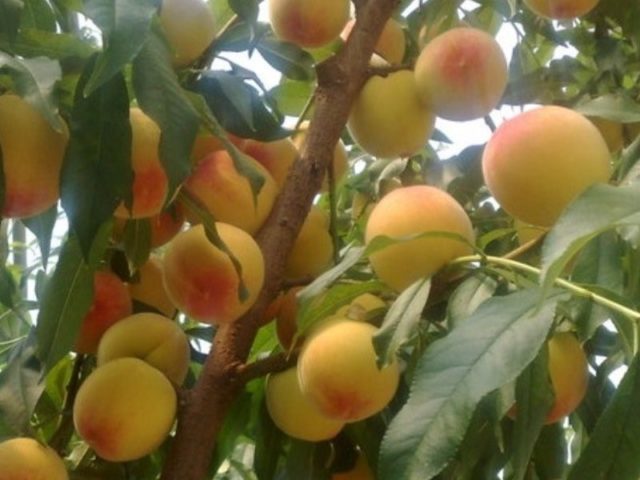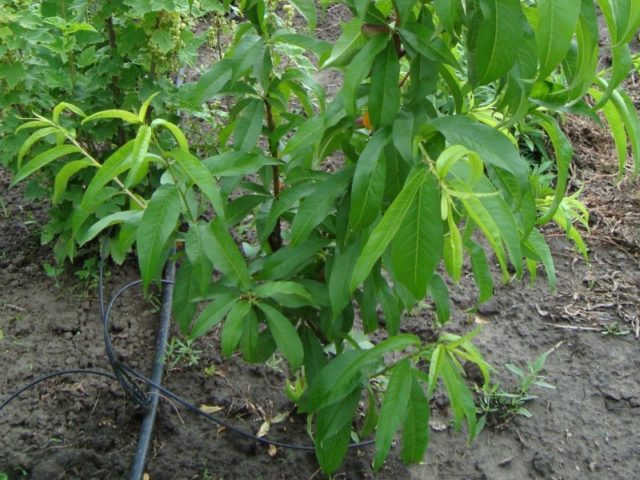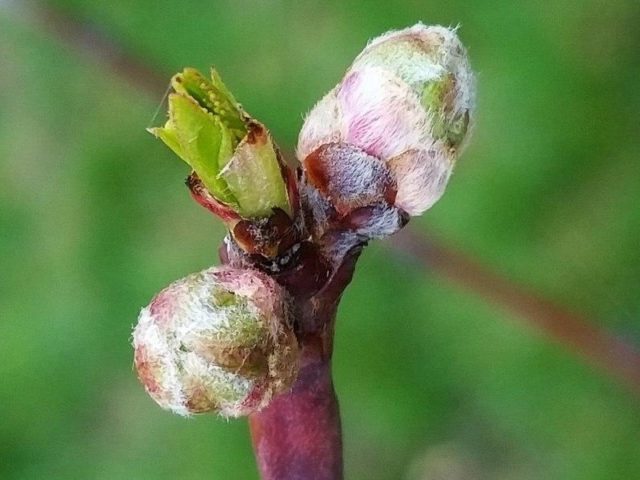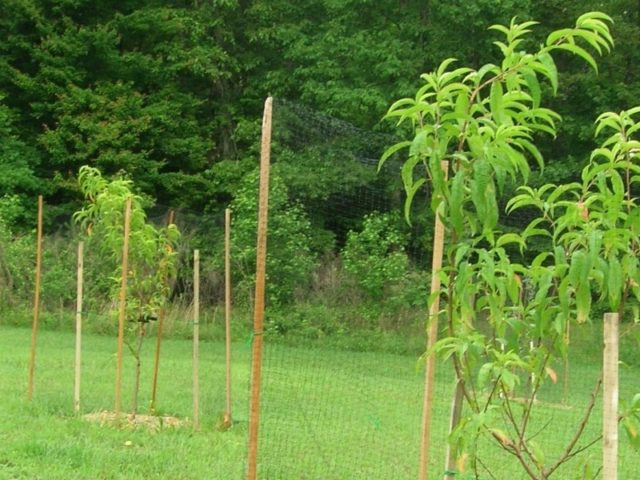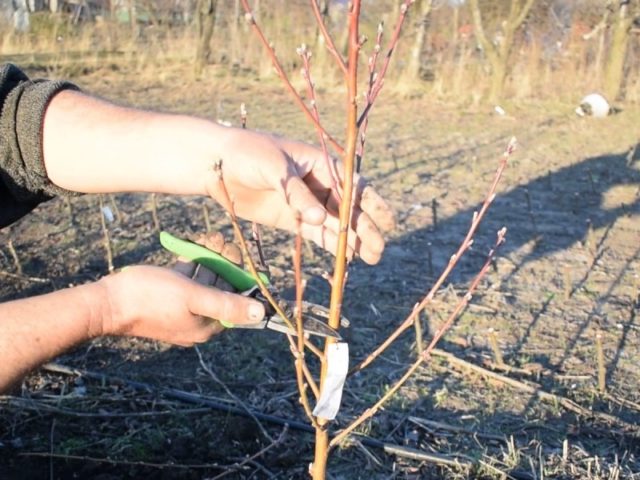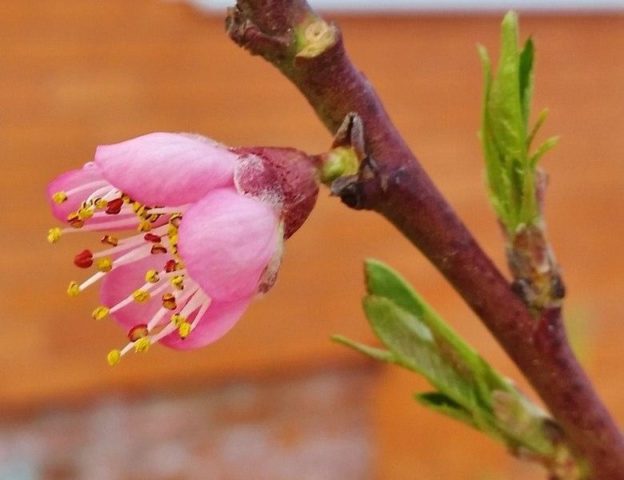Content
Veteran Peach is an old Canadian variety that still remains popular with gardeners. Its yield, as well as the characteristics of the fruit, are not inferior to new breeding developments. The tree is quite hardy if you follow all the rules of planting and agricultural technology.
Breeding history of the variety
Peach Veteran appeared thanks to Canadian breeders in 1925. Bred in Ontario. This is the result of crossing the Elberta early and Vaikan varieties. State test took place since 1948. Today it is one of the peach varieties in demand among gardeners.
Description of Peach Veteran
The Veteran peach variety has a medium-sized tree, the height of which does not exceed 4 m. The crown is spherical and dense. Fruits are rounded, their marketable weight is 135–185 g. Peach skin is Veteran of bright yellow color, with a reddish blush, which occupies most of its surface. The pulp is not very dense, yellowish, juicy, has a persistent and pronounced aroma.
In the photo, the Veteran peach matches the description:
The Veteran variety was included in the State Register in 1959. Recommended for cultivation in the North Caucasus region: in Kabardino-Balkaria, Krasnodar Territory, the Republic of Adygea. Veteran peaches ripen well in Crimea.
Characteristics of the variety
Due to its characteristics, this variety has not been losing ground for almost a hundred years. Its endurance, ripening period and fruit taste make Veteran one of the favorite crops of gardeners in the southern regions.
Drought resistance, frost resistance
Winter hardiness of the Veteran peach variety is rated above average in the description. In general, peach trees are hardy, but they are afraid of severe frosts. They survive a drop in temperature to -20-22 ° C, but at the same time there is a risk of damage to the buds, flower ovaries and roots located in the upper soil layer. The Veteran variety tolerates drought better than frosts. It is also heat resistant.
Does the variety need pollinators
Peach Veteran is self-fertile, that is, it does not need pollinators. But yields can increase if there are other varieties on the site.
Productivity and fruiting
The variety belongs to the early-growing - a young tree gives peaches already for 3 years. But harvesting before 5-6 years is not recommended to allow the plant to develop. The taste of the Veteran peach is assessed as good. When fully ripe, the fruit is sweet with a slight sourness.
Peach Veteran is shown in the photo:
The culture belongs to varieties with an average ripening period. The main crop is harvested from the second half of August. A mature tree produces 45-50 kg of fruit. A high yield is provided by many flower buds, which are laid annually.
Scope of the fruit
Peach fruits of the Veteran variety are versatile in use. According to gardeners, they are great for conservation. Their high taste also allows them to be consumed fresh. Peaches store well and tolerate transportation.
Disease and pest resistance
The Veteran peach is endowed with resistance to clasterosporium and cytosporosis. The tree has slightly less immunity to powdery mildew. It is attacked by aphids.
Advantages and disadvantages of the variety
According to the description, the peach of the Veteran variety has the following advantages:
- high productivity;
- good taste of fruits;
- early maturity;
- self-pollination;
- good indicators of keeping quality and transportability of fruits;
- resistance to clasterosporium and cytosporosis.
The disadvantages include a fairly low immunity to powdery mildew, as well as a strong thickening of the crown.
Peach planting rules
In order for the Veteran variety to take root and grow healthy, a number of rules must be observed when planting. Mistakes can even lead to the death of the tree. This is especially true when choosing a place for a peach and meeting planting dates.
Recommended timing
There is no consensus among gardeners about planting a peach: some prefer to do it in the fall, others in the spring. If you carry out the procedure before winter, then there is a risk that the young tree will not have time to root well and freeze. Spring planting is risky because the peach will suffer from pests and diseases.
This procedure cannot be performed in all regions in the fall. In temperate climates, only spring planting is possible. It makes sense to root a peach in autumn if winter comes in accordance with the calendar and the temperature does not drop below -15 ° C. That is, the tree should have 8-10 weeks in stock before frost in order to get stronger and survive the winter. In autumn, as a rule, there is more choice of seedlings, and they also have leaves and a developed root system, which makes it possible to judge their quality.
The Veteran Peach is planted when it is dormant. For the south of Russia, north-east and north-west of Ukraine, the recommended date is September 10-15. In Crimea, Krasnodar Territory and southern Ukraine, the Veteran variety can be planted until October 20, and if winter is predicted to come later, then until November 10.
In the temperate climate of the Ural and Siberian regions, peaches do not have time to form ovaries and ripen. Such trees can only be grown there in greenhouses and greenhouses.
Choosing the right place
Peach is picky about heat and sunlight. The culture does not tolerate transplantation very well, so you need to choose a place very carefully. The peach tree grows well in heat and drought conditions, but a draft and excessive dampness can destroy it.
They try to place the seedling on the south side of the site. It should not be overshadowed by any structures or other trees. On the north side, it is better to protect the peach with a fence or hedge, placing the seedling 2 m from the wall.
The tree should not be grown in lowlands, because the soil there often becomes waterlogged and cold air stagnates. Groundwater must pass at least 1.5 m from the surface. Peach trees grow very well on the southern or southeastern slopes of the hill.
The seedling should not be placed in a place where nightshades or melons grew before. Fungal diseases can be transmitted from sunflowers, strawberries, clovers and legumes. Rye and oats are good precursors for peach.
Yield indicators depend on the composition of the land. Sandy loam and loamy soils, as well as black soil, are best suited. There is sufficient humidity and a lot of lime. The peach tree will not grow on saline soils and places where there is a high content of carbonates.
Selection and preparation of planting material
The choice of a seedling is a very important stage, which determines how healthy and strong the tree will grow on the site over several years. The main points to consider when choosing a material:
- It is best to buy seedlings from nurseries located in the area where the peach will grow.
- You should not take the product at the lowest price.
- It is not worth buying a peach too early - it must be dug out during the dormant period, otherwise it will not take root well. In good seedlings, the shoots are covered with bark and the buds are fully formed.
- The variety must be suitable for the local climate in terms of characteristics.
- The choice of the age of the seedling depends on the experience of the gardener - it is better for beginners to take a 2-year-old peach with a height of 1.5 m and with 3-4 branches, but skilled ones can cope with an annual sapling in the form of a rod 1 m in height.
- In appearance, the tree should be strong and sturdy, without signs of damage or disease. A peach has a fibrous root system, therefore, you should not take a seedling with one root. Sluggish leaves and flaky bark should alert you - you don't need to buy such a plant.
If you had to buy a seedling far from the site and you need to transport it, it is worth remembering that it is harmed by sudden changes in temperature and humidity. The roots should be wrapped in a wet cloth, covered with polyethylene on top and fixed.
It is not recommended to immediately unpack the future tree - it is left in this form for 2 days. The day before planting, the seedling is placed in a container with clean water so that both the roots and branches are immersed. You can add a growth stimulant to the liquid.
Landing algorithm
2 months before planting, the site is cleared of stones and plant debris and dug up. Thus, the soil is saturated with oxygen. The size of the hole depends on the seedling, but it cannot be less than 0.5 m in depth, length and width. If necessary, drainage is made from expanded clay, pebbles or brick fragments. Its height is approximately 20 cm - this must be taken into account when planning the size of the pit.
The top layer of the earth is removed, but the rest of the soil from the pit is mixed with 2 buckets of humus and 0.5 kg of wood ash and poured back into a cone. The Veteran peach planting algorithm looks like this:
- First, two supports are stuck into the pit - if you do this after, you can damage the roots.
- Then 6 liters of water are poured into it and wait until it goes into the soil.
- Next, the seedling is placed vertically and the roots are spread along the earthen slide. The root collar should be 3-5 cm above the ground.
- The soil is placed back into the pit, filling it to the brim.
- The peach is tied to the supports, but not too tight.
- After the plant is watered using 8-10 liters of water.
- The soil should be lightly tamped, stepping back from the trunk about 0.5 m, it is necessary to form an earthen roller 15 cm high.
- Further, mulching is carried out with peat, sawdust, dry leaves.
Peach follow-up care
Peach Veteran requires moisture in the soil. Top dressing is necessary in the spring - nitrogen-containing fertilizers are applied. Humus is also used. In the fall, the tree is fertilized with potash-phosphorus fertilizers.
If the seedling is well developed, then pruning is done immediately. Veteran peach needs crown formation because it tends to thicken. The pruning procedure is carried out from the very beginning of the appearance of the buds until they open. In the fall, after harvesting, the tree needs sanitary pruning - removing dry and diseased branches.
Reasons why pruning is necessary:
- maintaining a balance between crown and roots;
- ensuring the health of the tree;
- the peach will quickly enter the fruiting season;
- convenience in harvesting and processing wood.
Peach is a thermophilic culture, therefore, in regions with cold winters, it must be covered. This must be done if the temperature is below -20 ° C for more than a month. The main rule is to use natural materials that are breathable. Usually, the trunk is wrapped in burlap and covered with soil 30 cm high. This will also protect the rodent tree. The shelter is removed when the temperature is fixed at + 5–10 ° С.
Diseases and pests, methods of control and prevention
The Veteran peach is resistant to most common diseases, and aphids are its main pest. A number of preventive measures will help to avoid an insect attack:
- deletion weeds;
- removal of root growth;
- spring treatment with insecticides;
- timely pruning of diseased and dried branches.
The preparations "Intavir" and "Iskra" are effective against aphids; moreover, they decompose quickly. From folk remedies, wormwood, celandine and ash are widely used.
Conclusion
Peach Veteran rightfully deserves this fame. These fruits appear on the shelves of the southern regions every season and grow in many household plots. The cultivar's resistance to weather changes and most diseases makes it easy to grow, even for beginners.
